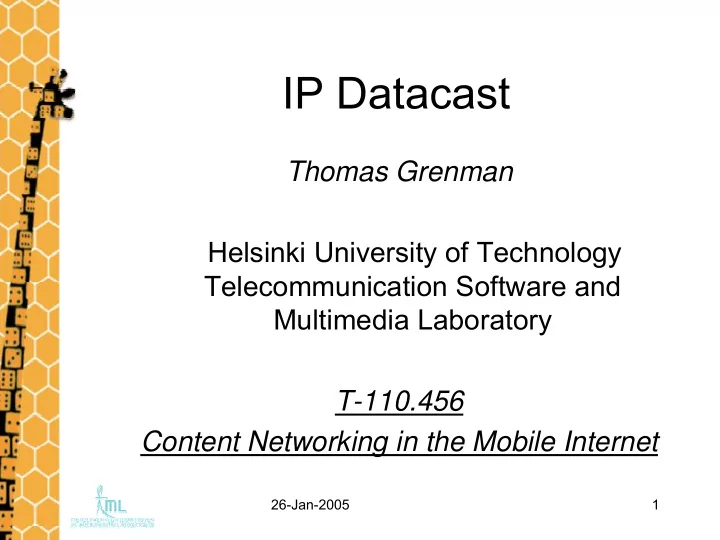

IP Datacast Thomas Grenman Helsinki University of Technology Telecommunication Software and Multimedia Laboratory T-110.456 Content Networking in the Mobile Internet 26-Jan-2005 1
Agenda • Introduction • Data bearers • Network architecture • Data capsulation • Standardisation • Conclusions • Helsinki trial (time permitting) 26-Jan-2005 2
Introduction • Two initiatives for IP multicasting in a mobile wireless environment – IP Datacast (IPDC) – Multimedia Broadcast Multicast Service (MBMS) • Reasons for multicasting – receiving interesting content – receiving content simultaneously – scalability – possible higher data rates than unicast 26-Jan-2005 3
Data bearers (1/2) • Possible physical broadcast-type bearers – DVB-T, DVB-S and DVB-H (Europe) – ISDB-T (Japan) – DAB (digital radio) • DVB-H is an optimised radio bearer for delivering data to a handheld device – reducing power consumption – increasing robustness – improving error correction 26-Jan-2005 4
Data bearers (2/2) • DVB-H can help save battery by up to 90% • The used technique is based on time slicing – data is delivered in burst (~ 2Mbit) – data rates are higher than can be consumed – the receiver’s idle time becomes significant • Neighbouring cells can be monitored during idle times (supports handover) • Goal: Usage times up to four hours without recharging 26-Jan-2005 5
Network architecture e Service and Delivery Management e System QoS-enabled backbone e Content Provisioning System S. Dixit & T. Wu: Content Net- Service System working in the Mobile Internet 26-Jan-2005 6
Data capsulation • Multicasted IP packets are encapsulated using multiprotocol encapsulation (MPE) • MPE datagrams are carried over a MPEG-2 transport stream (TS) as private data Header Payload IP Packet Header Payload MPE datagram CRC32 Header Payload Header Payload TS 26-Jan-2005 7
Ongoing standardisation • DVB-H is finalised and released (by ETSI) • DVB has issued a Call for Technologies to start standardisation of IPDC over DVB-H – electronic service guide – service purchase and protection – content delivery protocols – coding formats – quality of service – mobility and roaming 26-Jan-2005 8
IETF standards • Streaming – timely delivery rather than error free – real-time transport protocol (RTP) • Filecast – real time delivery or reliable delivery – file delivery over unidirectional transport (FLUTE) • Service discovery – announcing available IP multicast groups – service description protocol (SDP) 26-Jan-2005 9
Conclusions • Mobile IP multicast is a promising content delivery system • What will the required infrastructure cost? – UMTS vs. IPDC • Consumer reactions – can IPDC achieve commercial success? – are consumption habits likely to change? – what about the service categories: on-the-move, in-home, and in-office? 26-Jan-2005 10
Further reading • DVB TM-CBMS http://www.dvb.org/index.php?id=79 • IPDC Forum http://www.ipdc-forum.org/ • ETSI standards (e.g. DVB-H) http://pda.etsi.org/pda/ • RFC 1889 (RTP), RFC 2327 (SDP) and RFC 3926 (FLUTE) 26-Jan-2005 11
Helsinki trial (1/3) • A commercial trial is about to start – Duration: March – June 2005 – Transmitters: Pasila, Erottaja and Roihupelto – Network coverage: Area inside Kehä I – Users: 500 (TeliaSonera and Elisa customers) – Terminal: Nokia 7710 (with additional streamer) – Pricing: Fixed monthly fee (+ordered services) – Free TV-services: TV1, MTV3, Nelonen – Free radio services: Radio Peili, X3M, Nova – Premium TV-services: CNN, Euronews, Viva+, Fashion TV, BBC World… 26-Jan-2005 12
Helsinki trial (2/3) 26-Jan-2005 13
Helsinki trial (3/3) • Technical parameters (DVB-H) – Frequency: 610 MHz (UHF channel 38) – Transmission mode: 8k – Modulation: QPSK – Guard interval: ⅛ – FEC rate: ½ – Total multiplex bitrate: ~5.5 Mbit/s – Video codec: H.263 (ITU-T) – Video bitrate: ~250 kbit/s (QCIF, 15 fps) – Audio codec: AMR-WB (3GPP) – Audio bitrate: 23.85 kbit/s 26-Jan-2005 14
Recommend
More recommend